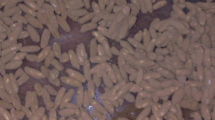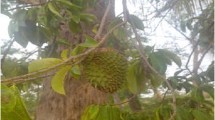Abstract
Aedes aegypti is the vector for transmitting dengue, chikungunya, and yellow fever. These diseases’ transmission has increased predominantly in urban and semi-urban areas as a major public health concern. In present investigation, Trichoderma atroviride culture filtrates were used for the synthesis of silver nanoparticle. Moreover, T. atroviride is a free-living and rapidly growing fungi common in soil and root ecosystem. This fungi is an exceptionally good model for biocontrol and more significant as a bioagent. T. atroviride was grown in malt extract. T. atroviride culture filtrates were exposed to silver nitrates solution for 24 h at 25 °C for the synthesis of silver nanoparticles (AgNPs). These AgNPs were characterized to find their unique properties with UV-visible spectrophotometer and transmission electron microscope (TEM) analysis. The T. atroviride culture filtrates have formed hexagonal (diamond shape) AgNPs with the range of size of 14.01–21.02 nm. These AgNPs have shown significant efficacies against first, second, third, and fourth instar larvae of A. aegypti. The LC90 and LC99 values for the first instar were 1 and 3 ppm, second instar 2 and 3.18 ppm, third instar 3.12 and 4.12 ppm, and fourth instar 6.30 and 6.59 ppm, respectively, after an exposure of 7 h. The confocal laser scanning microscopy (CLSM) studies were verdict that these AgNPs embedded in the cuticle of larvae and cause instant lethality in 7 h. Present investigations have demonstrated that the AgNPs of T. atroviride culture filtrates synthesized can be used for larvae control of A. aegypti. T. atroviride is synthesized to silver nanoparticles to be a promising new candidate for application in mosquito control. We therefore suggested that the ability of T. atroviride culture filtrates in synthesis can also be explored for synthesizing silver nanoparticles for commercial exploitation.






Similar content being viewed by others
References
Arjunan NK, Murugan K, Rejeeth C, Madhiyazhagan P, Barnard DR (2012) Green synthesis of silver nanoparticles for the control of mosquito vectors of malaria, filariasis, and dengue. Vector Borne Zoonotic Dis 12(3):262–268
Barik TK, Kamaraju R, Gowsoami A (2012) Silica nanoparticles: a potential new insecticide for mosquito vector control. Parasitol Res 111:1075–1083
Chan YS, Mat Don M (2013) Biosynthesis and structural characterization of Ag nanoparticles from white rot fungi. Mater Sci Eng 33:282–288
Fang J (2010) A world without mosquitoes. Nature 466:432–434
Ffrench-Constant RH (2005) Something old, something transgenic, or something fungal for mosquito control? Trends Ecol Evol 20:577–579
Finney DJ (1971) Probit analysis, 3rd edn. Cambridge University Press, Cambridge
Kumar KR, Nattuthurai N, Gopinath P, Mariappan T (2014) Synthesis of eco-friendly silver nanoparticles from Morinda tinctoria leaf extract and its larvicidal activity against Culex quinquefasciatus. Parasitol Res. doi:10.1007/s00436-014-4198-9
Marimuthu S, Rahuman AA, Rajakumar G, Santhoshkumar T, Kirthi AV, Jayaseelan C, Bagavan A, Abduz ZA, Elango G, Kamaraj C (2011) Evaluation of green synthesized silver nanoparticles against parasites. Parasitol Res 108:1541–1549
Marimuthu S, Rahuman AA, Kirthi AV, Santoshkumar T, Jayaseelan C, Rajkumar G (2013) Eco-friendly microbial route to synthesize cobalt nanoparticles using Bacillus thuringiensis against malaria and dengue vector. Parasitol Res 112:4105–4112
Mohanpuria P, Rana NK, Yadav SK (2008) Biosynthesis of nanoparticles: technological concepts and future applications. J Nanopart Res 10:507–517
Oksanen T, Pere J, Paavilainen L, Buchert J, Viikari L (2000) Treatment of recycled kraft pulps with Trichoderma reesei hemicellulases and cellulases. J Biotechnol 78(1):39–44
Patil CD, Borase HP, Patil SV, Salunkhe RB, Salunke BK (2012) Larvicidal activity of silver nanoparticles using Pergularia daemia plant latex against Aedes aegypti and Anopheles stephensi and nontarget fish Poecillia reticulate. Parasitol Res 111:555–562
Priyadarshini KA, Murugan K, Paneerselvam C, Ponarulselvam S, Hawang JS, Nicoletti M (2012) Biolarvicidal and pupicidal potential of silver nanoparticles synthesized using Euphorbia hirta against Anopheles stephensi (Diptera: Culicidae). Parasitol Res 111:997–1006
Rajkumar G, Rahuman AA (2011) Larvicidal activity of synthesized silver nanoparticles using Eclipta prostrata leaf extract against filariasis and malaria vector. Acta Trop 118:196–203
Read AF, Lynch PA, Thomas MB (2009) How to make evolution proof insecticides for malaria control. PLoS Biol 7, e1000058
Salunkhe RB, Patil SV, Patil CD, Salunke BK (2011) Larvicidal potential of silver nanoparticles synthesized using fungus Cochliobolus lunatus against Aedes aegypti (Linnaeus, 1762) and Anopheles stephensi Liston (Diptera: Culicidae). Parasitol Res 109:823–831
Santhoshkumar T, Rahuman AA, Rajakumar G, Marimuthu S, Bagavan A, Jayaseelan C, Zahir AA, Elango G, Kamaraj C (2011) Synthesis of silver nanoparticles using Nelumbo nucifera leaf extract and its larvicidal activity against malaria and filariasis vectors. Parasitol Res 108(3):693–702
Santhoshkumar T, Abdul Rahuman A, Bagavan A, Marimuthu S, Jayaseelan C, Vishnu Kirthi A, Kamaraj C, Rajakumar G, Abduz Zahir A, Elango G, Velayutham K, Iyappan M, Siva C, Karthik L, Bhaskara Rao KV (2012) Evaluation of stem aqueous extract and synthesized silver nanoparticles using Cissus quadrangularis against Hippobosca maculate and Rhipicephalus (Boophilus) microplus. Exp Parasitol 132:156–165
Sintubin L, Verstraete W, Boon N (2012) Biologically produced nanosilver: current state and future perspectives. Biotechnol Bioeng 109:2422–2436
Soni N, Prakash S (2012) Efficacy of fungus mediated silver and gold nanoparticles against Aedes aegypti larvae. Parasitol Res 110:175–184
Soni N, Prakash S (2014a) Microbial synthesis of spherical nanosilver and nanogold for mosquito control. Ann Microbiol 64:1099–1111
Soni N, Prakash S (2014b) Silver nanoparticles: a possibility for malaria and filaria vector control technology. Parasitol Res 113:4015–4022
Suganya G, Karthi S, Shivkumar MS (2014) Larvicidal potential of silver nanoparticles synthesized from Lecus sapera leaf extracts against dengue vector Aedes aegypti. Parasitol Res 113:1673–1679
Sundaravadivelan C, Padmanabhan MN (2014) Effect of mycosynthesized silver nanoparticles from filtrate of Trichoderma harzianum against larvae and pupae of dengue vector Aedes aegypti L. Environ Sci Pollut Res 21:4624–4633
Sundravadivelan C, Padmanabhan MN, Sivaprasath P, Kishmu L (2013) Biosynthesized silver nanoparticles form Pedilanthus tithymaloides leaf extract with anti-development activity against larval instars of Aedes aegypti L. (Diptera: Culicidae). Parasitol Res 112:303–311
Veerakumar K, Govindrajan M, Rajeswary M, Muthukumaran U (2014a) Lowcost and eco-friendly green synthesis of silver nanoparticles using Feronia elephantum (Rutaceae) against Culex quinquefasciatus, Anopheles stephensi, and Aedes aegypti (Diptera: Culicidae). Parasitol Res 113:1775–1785
Veerakumar K, Govindrajan M, Rajeswary M, Muthukumaran U (2014b) Mosquito larvicidal properties of silver nanoparticples synthesized using Heliotropicum indicum (Boraginaceae) against Aedes aegypti, Anopheles stephensi, and Culex quinquefasciatus (Diptera: Culicidae). Parasitol Res 113:2363–2373
Veerakumar K, Govindrajan M, Hoti SLU (2014c) Evaluation of plant-mediated synthesized silver nanoparticles against vector mosquitoes. Parasitol Res. doi:10.1007/s00436-014-4147-7
Vinale F, Sivasithamparam K, Ghisalberti EL, Marra R, Woo SL, Lorito M (2008) Trichoderma plant pathogen interactions. Soil Biol Biochem 40:1–10
World Health Organization (2005) Guidelines for laboratory and field testing of mosquito larvicides. WHO/CDS/WHOPES/GCDPP/13, 2005
World Health Organization (2014) Dengue and serve dengue. Fact Sheet. http://www.who.int/mediacentre/factsheets/fs117/en/
Acknowledgments
This work was funded by the Department of Science and Technology (DST), New Delhi, under Fast Track scheme of the Science and Engineering Research Board. We sincerely thank Prof. P.K. Kalra, Director, Dayalbagh Educational Institute, for his encouragements for this research. We are also thankful to DST-FIST program (2003–2008) for providing the laboratory facilities in the Department of Zoology. We sincerely thank the AIIMS New Delhi for Sophisticated Analytical Instrument Facility for Electron Microscopy and for Confocal Laser Scanning Microscopy the Advanced Instrumentation Research Facility (AIRF) JNU New Delhi. G. Singh is indebted to DST-SERB, New Delhi, for the award of Fast Track Young Scientist project (SR/FT/LS-01/2012), to conducts this study.
Author information
Authors and Affiliations
Corresponding author
Additional information
Responsible editor: Philippe Garrigues
Rights and permissions
About this article
Cite this article
Singh, G., Prakash, S. Virulency of novel nanolarvicide from Trichoderma atroviride against Aedes aegypti (Linn.): a CLSM analysis. Environ Sci Pollut Res 22, 12559–12565 (2015). https://doi.org/10.1007/s11356-015-4531-6
Received:
Accepted:
Published:
Issue Date:
DOI: https://doi.org/10.1007/s11356-015-4531-6




